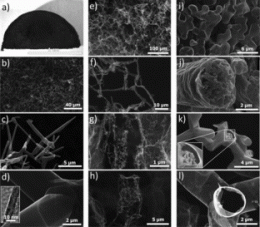Overview of different Aerographite morphologies by controlled derivations of synthesis. Image from Adv. Mater., 24: 3486-3490.
(Phys.org) -- Despite having a reputation for valuing intellectual prowess over physical abilities, scientists are nonetheless just as competitive as anyone else. Evidence of it exists in various fields of science as suggested by the assorted prizes that are awarded for those who achieve firsts in their particular realm of research. Also always popular are virtual contests to see who can create the smallest thing, or the largest, on in the case of aerographite, the lightest. This latest champion has been produced by a team of researchers at the University of Kiel in Germany. It’s based on carbon nanotubes and is being heralded as the lightest solid ever created.
Previous champions, aerogel, and then metallic microlattice were praised in their day for not just being the lightest stuff around, but for being strong for its size as well. Aerographite beats them both in both categories. Not only is it less dense (0.2 milligrams per cubic centimeter compared to 0.9) but it’s stronger too, able to support over 40,000 times its own weight. And since it’s actually mostly air (99.99%) it can be crumpled down to almost nothing if need be because it will spring back to its originally shape without prodding. Because the new champion is four times lighter than the previous champ, researchers will be busy looking for applications for it. The current hope is that because it’s a good conductor of electricity, it can be used as an electrode in new kinds of batteries or perhaps in supercapacitors.
The researchers created the new material by implementing a new kind of single-step CVD synthesis process based on freely adjustable networks using zinc oxide as a template, which in essence means, they found a new way to make the graphite grow in ways that develop into very thin strand hollow carbon nanotube structures that hold together to form a new kind of material.
Interestingly, the team says that if enough of the material were made to allow it to be seen by the naked eye, which they say they can do, it would appear as a black clump of sponge-like material. They also note that they didn’t start out trying to invent a new material but found it came naturally as part of their research into three-dimensionally cross-linked carbon structures.
More information: Mecklenburg, M., Schuchardt, A., Mishra, Y. K., Kaps, S., Adelung, R., Lotnyk, A., Kienle, L. and Schulte, K. (2012), Aerographite: Ultra Lightweight, Flexible Nanowall, Carbon Microtube Material with Outstanding Mechanical Performance. Adv. Mater., 24: 3486–3490. doi: 10.1002/adma.201200491
Abstract
An ultra lightweight carbon microtube material called Aerographite is synthesized by a novel single-step chemical vapor deposition synthesis based on ZnO networks, which is presently the lightest known material with a density smaller than μg/cm3. Despite its low density, the hierarchical design leads to remarkable mechanical, electrical, and optical properties. The first experiments with Aerographite electrodes confirm its applicability.
© 2012 Phys.org
























